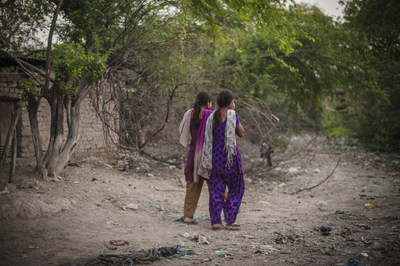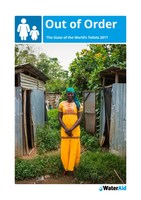Out of Order: WaterAid reveals where in the world it is hardest for women to find a toilet
OTTAWA, Nov. 16, 2017 /CNW/ - More than 1.1 billion women and girls around the world, one in every three, still have nowhere decent to go to the toilet. This injustice results in an increased risk of poor health, limited education, harassment and even attack.
'Out of Order,' WaterAid's third-annual analysis of the world's toilets, released ahead of World Toilet Day on November 19, reveals that Ethiopia is now worst in the world with the highest percentage of its population without toilets, while India remains the nation with the most people without toilets.


A staggering 93 per cent of Ethiopia's population still lack access to a basic toilet, the highest percentage of people living without decent toilets of anywhere in the world. Conversely Ethiopia has also made the most progress in reducing open defecation, from nearly 80 per cent in 2000 to 27 per cent in 2015, largely by investing in rudimentary community latrines.
India tops the list for the longest line-up for the toilet. With more than 355 million women and girls still waiting for access to basic sanitation, this line would stretch around the Earth more than four times. There is good news in India. The Swachh Bharat (Clean India) Mission has helped put India in the top 10 for reducing open defecation and improving access to basic sanitation.
Among the other findings:
- All 10 of the world's worst countries for access to basic sanitation are in sub-Saharan Africa, where only 28 per cent of people have a decent toilet, and children are 14 times more likely to die before the age of five than in developed regions.
- Djibouti, a major route for refugees from the Yemen war, has the worst figures for open defecation, with a 7.2 per cent increase since 2000.
- Madagascar – known as an 'aid orphan' due to its reputation for political instability – features in the top three for the most people without decent toilets as well as for failing to address open defecation.
- Between 2000 and 2015, the number of people in the world defecating in the open dropped from 1.2 billion (20 per cent of the global population) to 892 million (12 per cent). Despite this progress, it is still a huge problem, resulting in enough feces to fill seven bathtubs every second going into the environment untreated.
- Cambodia has emerged from decades of conflict to become one of the fastest growing economies in Asia. It comes second for progress in reducing open defecation as well as improving access to basic sanitation.
Nicole Hurtubise, WaterAid Canada's Chief Executive officer, said:
"If we consider the incredible liberties we enjoy in this country–this reality is incomprehensible. Having to find a safe place to go in the open is undignified and unsafe. A community without toilets is particularly hard for women and girls. For women who must defecate in the open, going to the toilet means shame, or worse the possibility of being attacked.
Through the Sustainable Development Goals, the world has promised everyone will have a safe toilet by 2030. While we are making progress, it isn't fast enough."
WaterAid is calling on the federal government to:
- Invest more money and spend it transparently and efficiently, helping to protect and preserve the needs of women and girls. This must include access to safe toilets.
- Promote the value of sanitation for gender equality and female empowerment, and involve women as leaders to ensure solutions address the challenges women and girls face.
- Improve coordination to create gender-friendly toilets in all schools, healthcare facilities, work environments and public spaces.
- Combine efforts to improve access to sanitation with water and hygiene work, which is predominantly the responsibility of women and girls.
About WaterAid
WaterAid's vision is of a world where everyone has access to clean water and sanitation. The international organisation works in 35 countries across Africa, Asia, Latin America and the Pacific Region to transform lives by improving access to clean water, hygiene and sanitation in some of the world's poorest communities. Since 1981, WaterAid has reached 25 million people with clean water and, since 2004, 24 million people with sanitation. For more information, visit www.wateraidcanada.com.
SOURCE WaterAid Canada

Christine LaRocque, Director of Communications and Engagement, [email protected], (613) 250-0781
Share this article